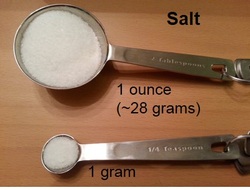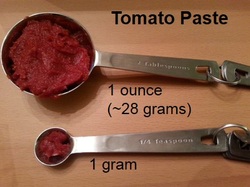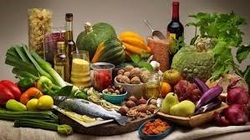
Elsewhere, food is measured in milligrams, grams and kilograms, and liquids in milliliters and liters (or millilitres and litres, depending on where you’re from). And quite simply, there are 1,000 milligrams in a gram, 1,000 grams in 1 kilogram and 1,000 milliliters in 1 liter. That’s it. That’s all you need to know to measure foods and liquids using the metric system.
Given that most Americans do not understand the metric system, I find it interesting that dietary recommendations and nutritional labels in the U.S. are written in terms of grams. Grams of protein. Grams of dietary fiber. Grams of carbohydrates. Grams of fat. The problem is that we don't know how to convert between the English and metric systems.
So, what is a gram and what does a gram look like? Let’s start with a unit we are comfortable with, an ounce. An ounce of something roughly will fit into the palm of your hand. An ounce of salt takes up a little less than 2 tablespoons. An ounce of tomato paste takes up even less of those 2 tablespoons than an ounce of salt because the tomato paste is denser than the salt due to the higher liquid content.

How can you use this information? Knowing that a gram is close to ¼ teaspoon, you know that a teaspoon weighs approximately 4 grams. Knowing that an ounce is close to 2 tablespoons and weighs about 28 grams, you know that a tablespoon weigh roughly 14 grams.
This at least gives you a visual when you’re reading nutritional labels and helps you picture the amount of food being described in terms of grams.





 RSS Feed
RSS Feed